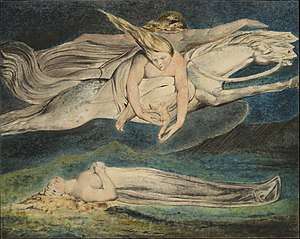Pity (William Blake)
Pity (c. 1795) is a colour print on paper, finished in ink and watercolour, by the English artist and poet William Blake, one of the group known as the "Large Colour Prints". Along with his other works of this period, it was influenced by the Bible, Milton, and Shakespeare.[2] The work is unusual, as it is a literal illustration of a double simile from Macbeth, found in the lines:
- And pity, like a naked new-born babe,
- Striding the blast, or heaven's cherubim, hors'd
- Upon the sightless couriers of the air.
- - Macbeth (1.7.21–23)[3]
| Pity | |
|---|---|
 | |
| Artist | William Blake |
| Year | 1795 |
| Type | Colour print, finished in ink and watercolour, on paper[1] |
| Dimensions | 425 cm × 539 cm (167 in × 212 in) |
| Location | Tate Gallery, London |

Like other members of the group it is a monotype produced by printing from a matrix consisting of paint on gessoed millboard, with each impression then finished by hand. By this unusual means Blake could obtain up to three impressions from a single painting. Three such impressions survive of Pity. A fourth, in the British Museum, was an early trial of the design from a different matrix, as it is smaller than the others.[4]
Interpretations
Martin Butlin wrote that this colour print is one of the most inspired of all 'literal' illustrations of a text in the history of art.[5] In fact, "pity and air", two words of the Shakespeare's verses, are also two motifs used by Blake in this picture: a female cherub leans down to snatch the baby from its mother. According to Blake biographer Alexander Gilchrist, the print "is on a tolerably large scale, a woman bending down to succour a man stretched out at length, as if given over to death."[6]
Pity is seen as in opposition to Blake's print The Night of Enitharmon's Joy (c. 1795) — which shows a Hecate surrounded by fantastic creatures and macabre elements of a nightmare — because it provides a "possibility of salvation" in the fallen world through pity.[7] Both prints refer to Macbeth. As Nicholas Rawlinson has noted, the play was undergoing a major revival in popularity at the time, being performed nine times in 1795.[8]
It is a personification[9] of a Christian element[10] that some critics argue was a negative virtue for Blake, since pity is associated with "the failure of inspiration and a further dividing"[11] and also "linked by alliteration and capitalization".[12] It is also a part of Blake's mythology, in which a sexually frustrated Tharmas becomes "a terror to all living things", although the emotion inherent in him is pity.[13] Other Blake characters have this feeling, and his mythology is developed between the confrontation of a feminine "Pity" and a masculine fiery, as happens in the brutal suppression of desire in Urizen.[14]
Some critics see a connection between Pity and the "hypnotic and helpless state" of William Butler Yeats' The Wind Among the Reeds (1899).[15]
Versions

The print exists in four versions from two different matrices. The most elaborate and best-known version of the print is in the Tate Gallery, London, sometimes described as the only finished one. It was presented by W. Graham Robertson to the gallery in 1939, and is catalogued as "Butlin 310".[16]
A unique "proof print" is in the British Museum (Butlin 313). It is "significantly smaller than the final version of the design" and depicts the supine figure "partially covered in vegetation" in the form of sweeping fronds of long grass.[17]
Another version of the image is in the collection of the Metropolitan Museum of Art. This is not as elaborately worked as the Tate print. It was donated by Mrs. Robert W. Goelet in 1958.[18]
A lightly retouched version at the Yale Center for British Art also exists, somewhat yellowed by varnish. According to The Wiliam Blake Archive, "The characteristics of the color printing indicate that this impression is the first one printed from the larger matrix in 1795. The second impression in this printing is Pity in the Tate Collection (Butlin 310); the third impression is in the Metropolitan Museum of Art, New York (Butlin 311)."[19]
References
- "Pity" Photograph. Encyclopædia Britannica Online. Consulted on 2 Oct. 2010.
- Metropolitan Museum of Art (1980). The painterly print: Monotypes from the seventeenth to the twentieth century [exhibition], p. 84.
- Bindman, David (1977). Blake as an Artist. Phaidon. p. 106.
- Blake Archive.org, "The Large Color Printed Drawings of 1795 and c. 1805"
- Blutin, Martin. The Evolution of Blake's Large Color Prints of 1795, in William Blake: Essays for S. Foster Damon, ed. Alvin Rosenfeld (Providence: Brown University Press 1969), p. 109.
- Gilchrist wrote "a man" because he looked a version of the print without color. Gilchrist, Alexander (1863). Life of William Blake, "Pictor ignotus": With selections from his poems and other writings Macmillan and Co., p. 253.
- Butlin, Martin (1990). William Blake 1757-1827. Tate Gallery Collections, V, London
- Rawlinson, p. 48.
- Gilchrist, Alexander (1907). The Life of William Blake. John Lane, The Bodley Head. p. 479
- Chesterton, G.K. (2005). William Blake. Cosimo, Inc. ISBN 1-59605-016-0. p. 118
- Butlin, Martin (1978). William Blake. Tate Gallery. p. 56
- Rawlinson, p. 171.
- Davis, Michael (1977). William Blake: a new kind of man. University of California Press. ISBN 0-520-03443-0. p. 78
- Eaves, Morris (2003). The Cambridge Companion to William Blake. Cambridge University Press. p. 217. ISBN 0-521-78677-0.
- O'Neil, Patrick M. (2004). Great World Writers: Twentieth Century. Juvenile Nonfiction. p. 1708.
- All Butlin numbers from the Blake Archive pages on each work
- The British Museum The Large Colour Prints / Pity.
- Metropolitan Museum of Art, Pity, William Blake (British, London 1757–1827 London
- Morris Eaves, Robert Essick, Joseph Viscomi, et al The William Blake Archive
External links
- Pity by William Blake. Page on Tate Gallery official website.
- Tate Learning. Artists in Focus: William Blake in Tate official website.
